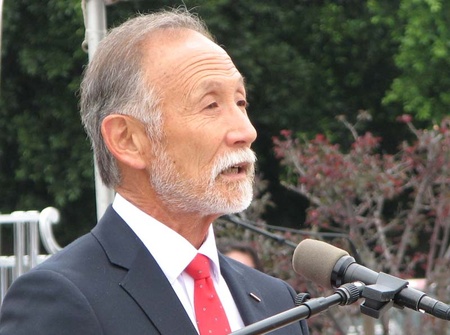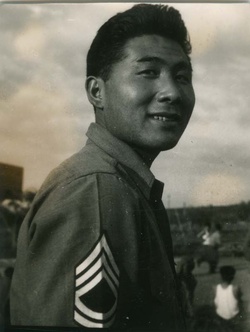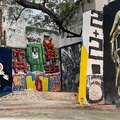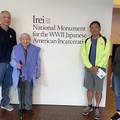As the sun peeked out on a slightly overcast summer’s day, a few WWII veterans gathered with a crowd of friends and families on the occasion of the 15th Anniversary of the Go For Broke Monument in the heart of Little Tokyo. Mostly in their 90s, the white-haired men carried canes and walked slowly. Seeming slightly weary from the attention they had been receiving from the Congressional Gold Medal, they’ve always been known to us as humble men who were heroes in a war that demanded their combat service while their families were imprisoned.
As 100th Infantry Battalion veteran Masao (“Mas”) Takahashi stood onstage next to his compatriots from the Greatest Generation, the small platform seemed larger than life. On this day, however, the spotlight was on a man who stood in their shadow. That day he was the keynote speaker who opened with the words, “Most of you are probably wondering who I am and why I’m here. Me, too. I’m Scott Takahashi, a sansei and Vietnam veteran and son of a Nisei WWII veteran.”
Typical of children of the quiet Nisei, humility runs through Scott’s blood. Even though his father Mas never received a Purple Heart (although a record 9,486 of his fellow 100th Infantry/442nd Regimental Combat Team soldiers did), both of them undeniably came close to death in wars that claimed hundreds of thousands of lives. Vietnam vet Scott actually received a Purple Heart but never spoke about it. “I shouldn’t have accepted it,” he said softly to me in private. “I never left the field. It was just a shrapnel wound that didn’t even require medevac.” Several fellow soldiers were airlifted the night he was injured; fortunately Scott was not one of them.
While honoring the heroes whose names grace the Monument, Scott spoke mostly about his father and his family. Since war has always been a necessary way of life for Americans armed with ideological goals of defending freedom and protecting against oppression, its cost has never been felt more fully than by families who’ve sent fathers, uncles, and sons into battle. The Takahashis were one such family who tried unsuccessfully to keep their families intact.
In 1942, Mas’s older brother Yoshio (“Weesh”) volunteered to serve and ended up in “M” Company of the 442nd Regimental Combat Team. Because he didn’t want to lose his other sons to war, their father had tried to keep Mas and another son from volunteering, but ultimately Mas was drafted after the family left the Manzanar camp to live in Detroit. In addition to his father and uncle who served, two of Scott’s uncles on his mother’s side (then Elma Amamoto) were also called into the military: Elma’s brother Kenneth Amamoto was with the 6th Armored Field Artillery Battalion and brother-in-law Harvard Yuki was a member of the Military Intelligence Service (MIS).
There’s probably not a more difficult subject for any veteran than talking about combat. Listening to reports of huge casualties is one thing, watching men die beside you is another. Like many of the men drafted out of camp, Mas’ basic training at Camp Blanding was cut short as replacements were rapidly being sought to replenish the huge number of losses suffered by the all-Japanese American units. All told, the unit would suffer a staggering casualty rate of more than 300%.
Mas ended up in France as a rifleman with the 100th Infantry Battalion. Even though Scott’s job in Vietnam (“A” Battery of the 2nd Battalion, 35th Artillery) involved sitting atop an M109 howitzer with a roof-mounted machine gun, he claimed his father’s duty was far worse. His father carried a BAR (Browning Automatic Rifle), and according to Mas, it was so heavy the job of carrying it was relegated to newcomers who didn’t know any better.
After serving on patrol in the Champagne Campaign, Mas’ mettle was tested when the 100th Infantry was sent to the treacherous Gothic Line, a mountainous area surrounded by the Italian Appenines and the Austrian Alps. American forces had been trying to penetrate the area for months, and the artillery barrage was so constant that Mas remembers arriving to find the ground powdery. Climbing up and down steep mountains with machine gun fire and hand grenades overhead, Mas will never forget the cries of a soldier constantly moaning “mama” in the dark of the night. Experiences like these, said son Scott, himself a seasoned combat veteran, “never leave you.”
Scott spent six weeks after his 19-month active service driving on his own for 10,000 miles to see his country and to help him forget the reverberations of war. Two of his fellow artillerymen had agreed to join him, but one ran out of money and the other was diagnosed and later died from Hodgkin’s lymphoma, a likely victim of Agent Orange.
After returning home to Southern California, Scott decided to go back to school to pursue a career that would help him bury some of his guilt about his role in a war he found destructive to the pastoral landscape of this small country. “I needed to do something that made me feel good about me, and I wanted to give back,” he said. He ended up in the medical field as an x-ray technician, a job he held for 38 years.
He also wanted to give back to the men like his dad, who he long considered “true American heroes,” not only for their undeniable bravery in combat but for their role in liberating Japanese Americans from prejudice and discrimination. “There’s nothing we can do to repay the Issei and Nisei for the groundwork they laid for us,” according to this Sansei. Scott does all he possibly can through his volunteer work as co-president of the 100th Battalion Veterans Club, as well as spending much of his spare time helping out along with his dedicated wife, Susan, at the Go For Broke National Education Center office.
Throughout the years, Scott and his father have never spoken directly to one another about their wartime experiences, a practice all-too-common among Japanese American families, but it didn’t stop Scott from encouraging others to open the door to dialogue about their wartime experiences. As he spoke on this occasion before his father and other Nisei, he started by asking them to share their experiences, and then implored young people in the audience to keep asking questions: “You can start with simple, but sometimes painful questions: Were you in camp? Which camp? Were you in the service? What unit?” And so, he says, “The journey begins.”
Scott and Mas still see each other almost daily, but the dutiful son admitted that he can’t ever tell if his father is happy with what he’s doing. Nonetheless, by the time the sun shone brightly that day, it was clear to everyone else that Mas was indeed proud of his accomplished son. You could see it in Mas’ smiling face.
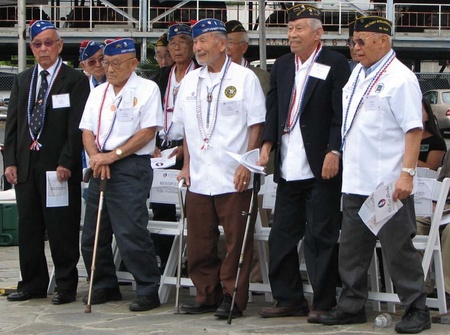
© 2014 Sharon Yamato


